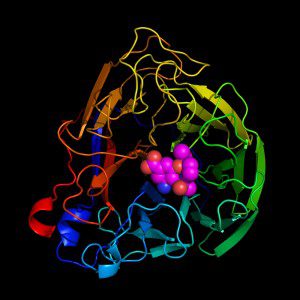

During the 2008-09 flu season oseltamivir resistant influenza H1N1 viruses with the H274Y change began to spread, and within a year they were found in most seasonal isolates. It was hypothesized that these viruses contained other amino acid changes that masked the deleterious effect of H274Y. The H274Y mutation does not affect the catalytic activity of the NA: the ability to cleave sialic acid from glycoproteins. However it does lead to a decease in the amount of NA protein that is transported to the surface of infected cells.
Computational methods were used to identify amino acids in NA that could potentially compensate for the effect of H274Y. A single amino acid change at position 194 of NA, when present with H274Y, restored NA on the cell surface to normal levels.
Did a similar amino acid change in seasonal H1N1 strains allow the spread of oseltamivir resistant viruses with H274Y? Introduction of this amino acid change into the seasonal H1N1 strains A/Texas/91 and A/New Caledonia/99 causes a decrease in surface NA. However the same change has a lesser effect on surface NA in cells infected with A/Solomon Islands/2006. Two amino acid changes were identified in the NA protein of recent oseltamivir-resistant seasonal H1N1 viruses that restore surface levels of NA in the presence of H274Y: V234M and R222Q.
It seems likely that the amino acid changes V234M and R222Q emerged first in the NA of seasonal H1N1 viruses. Why these changes appeared is unknown, but they could be a consequence of random drift, antigenic selection, or a need to balance HA and NA activities. Once these changes were in place, oseltamivir resistant viruses with the H274Y could be selected, and because they had no defect in fitness, they spread globally.
The conclusion is that H274Y in NA attenuates the fitness of influenza virus by reducing the amount of NA on the cell surface. Spread of such viruses in the population is impossible without secondary amino acid changes that restore adequate levels of surface NA. H274Y probably causes a defect in NA folding or transport that is balanced by the secondary mutations.
These findings are another example of how drug resistance frequently comes with a cost to protein stability or folding, and prevents evolution unless compensated by secondary mutations.
There have been scattered isolations of oseltamivir-resistant, pandemic 2009 H1N1 influenza virus with the H274Y change. Will these viruses spread globally, or are they less fit, evolutionary dead ends? Introduction of the H274Y change into the NA of 2009 pandemic H1N1 virus leads to a large decrease in surface NA. Unless the 2009 swine-origin viruses already produce excess NA, viruses with the H274Y change are not likely to spread without secondary mutations that rescue NA surface expression.
Bloom JD, Gong LI, & Baltimore D (2010). Permissive secondary mutations enable the evolution of influenza oseltamivir resistance. Science (New York, N.Y.), 328 (5983), 1272-5 PMID: 20522774

Pingback: Secondary changes allow spread of oseltamivir resistant influenza … | H1N1INFLUENZAVIRUS.US
Pingback: Tweets that mention Secondary changes allow spread of oseltamivir resistant influenza virus -- Topsy.com
Silly people. If a variant can reproduce enough to spread from host to host, even slowly, it will increase in virulence until it reaches evolutionary equilibrium or the practical limits of virulence.
Your statement is not true. There are many viruses that infect over
90% of humans without causing disease. And the point of this paper is
that the mutation causing tamiflu resistance could not spread without
a secondary mutation. It has nothing to do with virulence.
Correct. I misspoke somewhat. In broad brush, virulence tends to be correlated with the reproductive success of the organism causing it. That is only a broad brush, and it is more true within a quasi-species than between quasi-species. The reproductive success of the organism (in this case a virus) is regulated by its ability to attach, enter, reproduce, release and be communicated to a new host.
So in the case of a virus like influenza, if a mutation (otherwise deleterious) allows blocked release to occur, it will be communicated to other hosts. This can be a co-infection with other variants of the virus, or it can be singular. This allows evolution to have the chance to find the other compensating mutation(s). At roughly 10^-5 mutations per base pair, roughly 1 in 9 virus replications will have a mutation somewhere. There are a varying number of codons for the 20 amino acids possible, and only 2 out of the 64 codons code for tyrosine. Not up to calculating the number of replications to have a roughly 90% chance of covering the space this time in the morning, but it is a pretty large number since it's a random process (with complicating factors). When they occur in a host, they do not always get communicated from the host they occur in, because that will tend to happen later in the infection cycle, which lengthens the practical evolution time. But the huge numbers of virions produced compensate. (In the lungs of the crippled viruses, the one-legged virus is king.)
So that's what I meant, but did a lousy job of saying.
I would look first at animals myself, see if large scale piggeries, for instance, have been dosing herds consistently somewhere. (Particularly in colder regions.)
“Well , the coach outlet view of coach handbags the passage is totally correct ,your details is really reasonable and you guy give us valuable informative post, I totally agree the standpoint of upstairs. I often surfing on this forum when I m free and I find there are so much good information we can learn in this forum!
ugg gissella boots